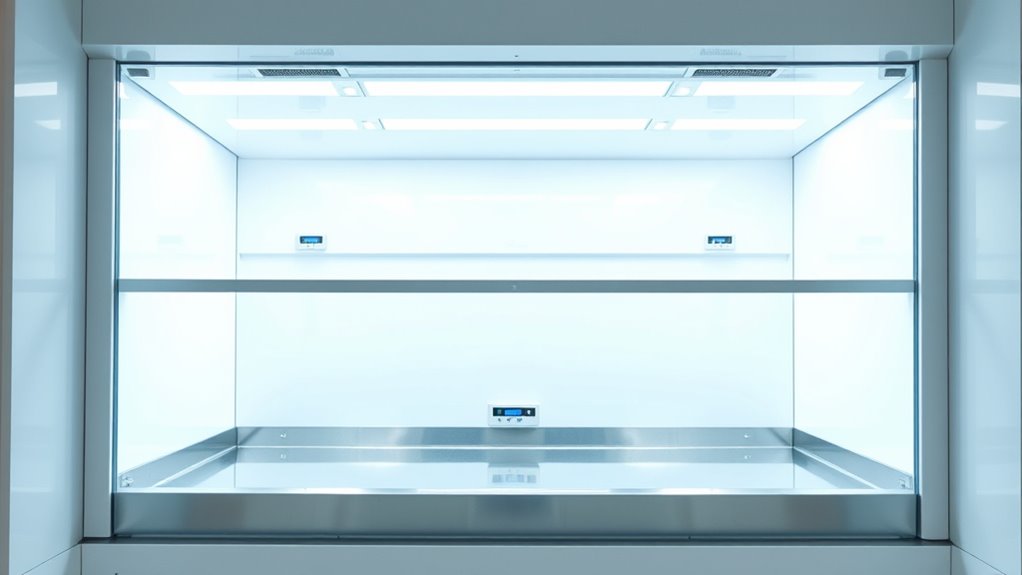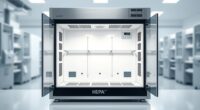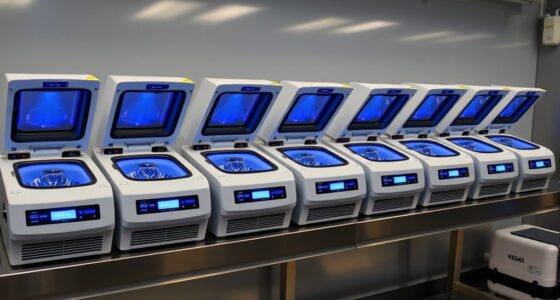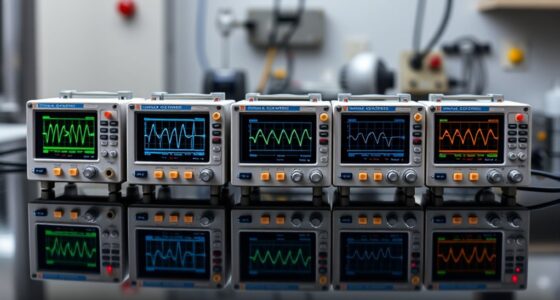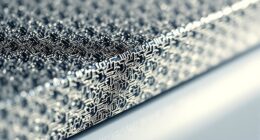If you’re searching for the 15 best cleanroom laminar flow hoods for 2025, I can help you find top options that suit medical, lab, and research needs. From compact 12-inch units to larger portable models like 24-inch and 18-inch hoods, I’ve identified products with HEPA/ULPA filters, adjustable airflow, and durable construction. Whether you need vertical or horizontal airflow, these hoods meet ISO Class 5 standards and are suited for sterile, contamination-free environments. Keep exploring to discover the best fit for your workspace.
Key Takeaways
- Prioritize units with ISO Class 5 certification, HEPA/ULPA filtration, and high particle removal efficiency for safety.
- Opt for portable, compact designs with adjustable airflow, LED lighting, and anti-static features for versatile, efficient workspaces.
- Consider models with durable construction materials like galvanized steel, aluminum blades, and copper motors for long-term reliability.
- Evaluate maintenance ease, including filter replacement intervals and surface cleaning, to ensure consistent performance.
- Match size and airflow capacity to your specific application, from small inoculation boxes to larger cleanroom hoods for various industry needs.
18” Portable Clean Room, Laminar Flow Hood for Medical & Lab Use
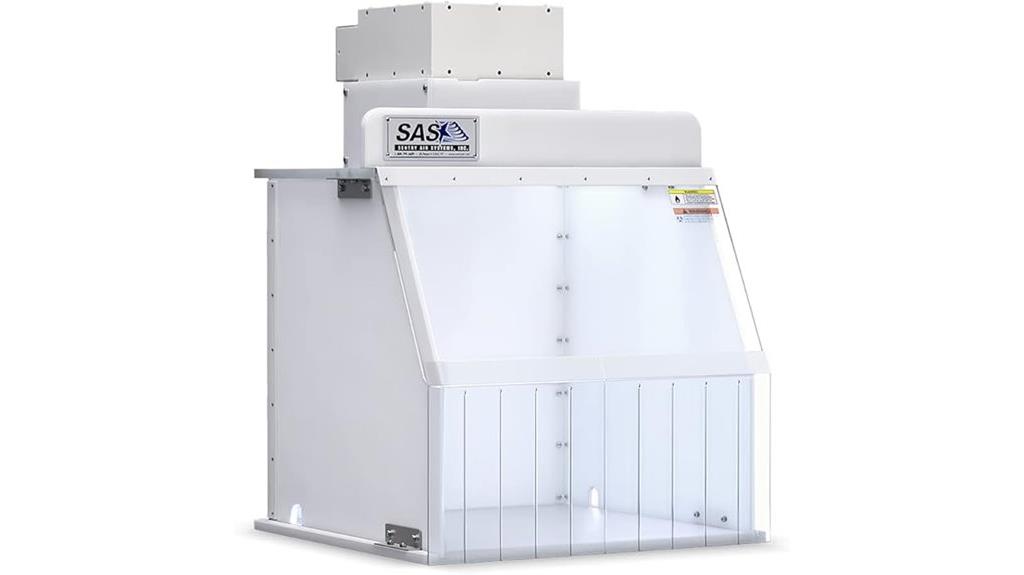
If you’re looking for a reliable, portable cleanroom solution for medical or laboratory work, the 18” Portable Clean Room Laminar Flow Hood is an excellent choice. It offers a compact, lightweight design that meets ISO Class 5 standards, making it ideal for tissue culture, IV prep, stem cell therapy, and research. The hood supplies filtered, positive-pressure airflow to keep environments particulate-free. Features like vertical laminar flow, LED lighting, anti-static curtains, and dual-stage filtration with HEPA or ULPA filters ensure high performance. Easy to assemble, low-maintenance, and energy-efficient, it seamlessly integrates into existing workspaces, providing a dependable clean environment wherever needed.
Best For: medical professionals, researchers, and labs needing a portable, ISO Class 5 clean environment for tissue culture, stem cell therapy, IV prep, and other sensitive applications.
Pros:
- Compact, lightweight design for easy setup and portability
- Effective dual-stage filtration with options for HEPA or ULPA filters
- Low-maintenance, energy-efficient operation with user-friendly assembly
Cons:
- Airflow may not be perfectly laminar across all points, with some directional variability
- Initial setup instructions can be vague, especially regarding filter removal and assembly steps
- Some reports of missing filters or minor assembly challenges for first-time users
24 Wide Portable Clean Room, Laminar Flow Hood for Medical & Lab Use
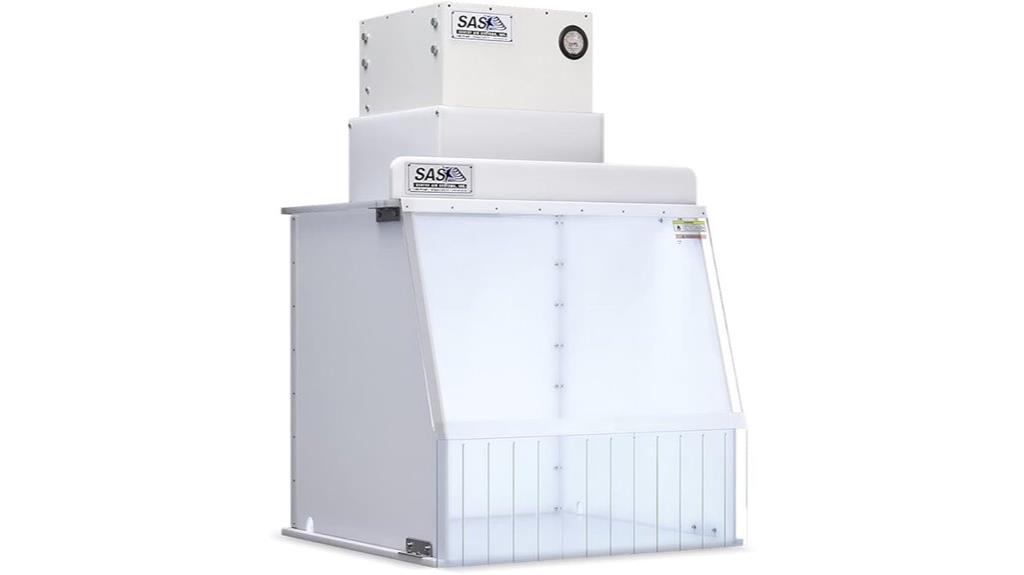
The 24” Wide Portable Clean Room Laminar Flow Hood is an ideal solution for laboratories and medical facilities that need a compact, easy-to-move clean environment. Its sleek design measures 24 D x 26 W x 39.5 H inches, making it perfect for tight spaces. Equipped with LED lighting, anti-static curtains, and a variable speed controller, it offers flexible operation. The unit employs dual-stage filtration—pre-filter (MERV 8) plus HEPA or ULPA filters—delivering ISO Class 5 cleanliness. It’s suitable for tissue culture, IV prep, stem cell work, and more. Easy to assemble, efficient, and quiet, it guarantees a sterile workspace with minimal hassle.
Best For: laboratories and medical facilities seeking a compact, portable clean environment for sensitive tasks like tissue culture and IV preparation.
Pros:
- Easy to assemble and integrate into existing workspaces with minimal effort
- Combines efficient dual-stage filtration with quiet, energy-efficient operation
- Features adjustable airflow and LED lighting for optimal visibility and control
Cons:
- Lacks detailed assembly instructions, which may require additional effort for setup
- Limited size may not accommodate larger equipment or high-volume tasks
- Some customers may desire more customizable features or additional filtration options
18” Portable Clean Room Laminar Flow Hood for Medical and Laboratory Use

Designed for medical and laboratory professionals who need a reliable, portable workspace, the 18” Cleanroom Laminar Flow Hood offers a compact solution that meets ISO Class 5 standards. It supplies filtered, positive-pressure airflow through vertical laminar flow, ensuring a particulate-free environment. Features include LED lighting, anti-static curtains, and dual-stage filtration with a pre-filter and a HEPA or ULPA main filter. Its small size—18.5” D x 20” W x 27.6” H—allows easy setup and integration into existing workspaces. Quiet, energy-efficient, and low-maintenance, this hood is ideal for tissue culture, stem cell therapy, IV prep, and other sensitive applications.
Best For: medical and laboratory professionals requiring a portable, reliable clean environment for tissue culture, stem cell therapy, IV prep, and other sensitive procedures.
Pros:
- Compact and portable design allows easy setup and integration into various workspaces
- Dual-stage filtration effectively removes particulates, ensuring ISO Class 5 standards are met
- Features like LED lighting and anti-static curtains improve usability and safety
Cons:
- Assembly may be challenging for users unfamiliar with construction or without clear step-by-step guidance
- Airflow may not be perfectly laminar across all points, potentially causing directional variability
- Some users report missing filters or vague instructions, which could affect setup and operation
HEPA H14-Filter Laminar Flow Hood with Fan Filter Unit
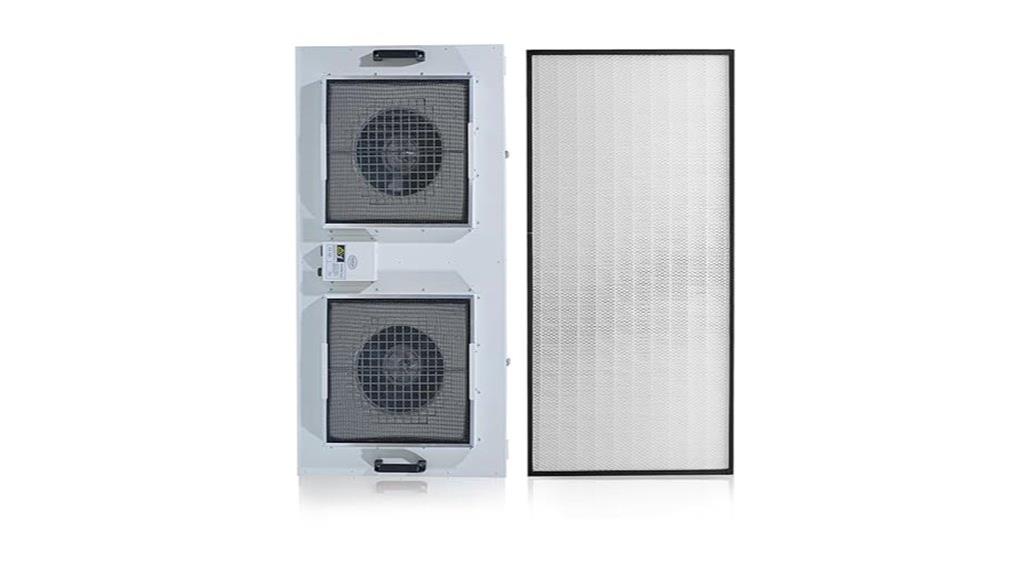
Looking for a reliable laminar flow hood that guarantees high-level filtration? The HEPA H14-Filter Laminar Flow Hood with Fan Filter Unit offers just that. It’s CE and ISO certified, removing 99.995% of particles ≥0.3 microns and meeting ISO Class 5 standards. Its sturdy galvanized frame, thickened metal casing, and durable copper motor ensure longevity and safety. Adjustable airflow speeds and a high airflow rate of 1900 m³/h let me customize operations. Suitable for cleanrooms, labs, tissue culture, and more, it maintains a sterile environment with consistent laminar airflow. Customers praise its solid build and effective filtration, making it a top choice for 2025.
Best For: laboratories, cleanroom facilities, and tissue culture environments requiring high-efficiency particle filtration and sterile airflow.
Pros:
- Certified CE and ISO standards ensuring reliable filtration efficiency of 99.995% for particles ≥0.3 microns
- Durable construction with galvanized frame, thickened metal casing, and copper motor for longevity and safety
- Adjustable airflow speeds and high airflow rate (1900 m³/h) for customizable operational needs
Cons:
- Shipping packaging occasionally results in minor dents or damages that do not affect performance
- Larger size may require adequate space for installation and operation
- Optional mounting bracket (ASIN: B0D475G6S4) is an additional purchase
Laminar Flow Hood 17″x13″ FFU Inoculation Box Fan Filter Unit

If you need a compact, reliable laminar flow hood for inoculation and sterile work, the 17″ x 13″ FFU Inoculation Box offers a practical solution. It features a dual fan system and a HEPA H12 filter that captures 99.9% of 0.3-micron particles, ensuring a sterile environment. Its overall size is 17.25 x 14.82 x 14.8 inches, with an operating space of 17.2 x 7.48 x 13.07 inches. Despite slow airflow at high speed, it maintains cleanliness effectively. The unit’s integrated filter box simplifies setup, but proprietary filters may limit replacement options, raising concerns over cost and availability.
Best For: laboratory professionals, mushroom cultivators, and researchers seeking a compact, reliable sterile work environment for inoculation and delicate sample handling.
Pros:
- Compact size with integrated filter box for easy setup and minimal assembly
- HEPA H12 filter captures 99.9% of 0.3-micron particles, ensuring high sterilization standards
- Effective airflow and positive feedback from users for maintaining sterile conditions
Cons:
- Proprietary filters limit replacement options, potentially increasing costs and reducing availability
- Slow airflow at high fan speed may cause turbulence and limit workspace efficiency
- Small work area may not accommodate larger samples or more demanding tasks
FFU HEPA H14-Filter Laminar Flow Hood
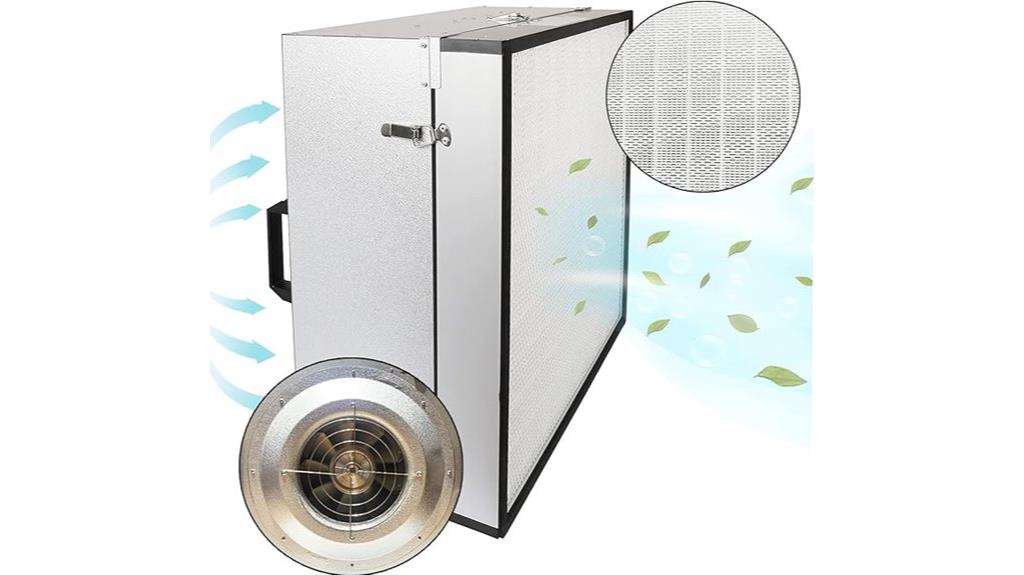
Are you seeking a reliable laminar flow hood that guarantees ultra-clean environments with minimal noise? The FFU HEPA H14-Filter Laminar Flow Hood offers CE and ISO certification, removing 99.995% of particles ≥0.3 microns and meeting ISO Level 5 standards. Its galvanized steel cabinet, copper motor, and aluminum blades ensure durability and smooth airflow. With adjustable three-speed regulation, it operates quietly at 41-65 dB and consumes only 200W. Designed for cleanrooms, labs, and electronics work, it’s easy to maintain—filters last 8-12 months, and regular particle checks keep performance ideal. This unit balances efficiency, reliability, and user convenience perfectly.
Best For: laboratories, cleanrooms, and electronics repair professionals seeking reliable, ultra-clean airflow with quiet operation and durable construction.
Pros:
- Certified to remove 99.995% of particles ≥0.3 microns, meeting ISO Level 5 standards
- Quiet operation at 41-65 dB with adjustable three-speed airflow
- Durable galvanized steel cabinet with copper motor and aluminum blades for long-lasting performance
Cons:
- Weighs 36.3 pounds, which may require assistance with setup or relocation
- Filter replacement cycle of 8-12 months requires regular maintenance and monitoring
- Customer ratings are moderate at 3.8 out of 5, indicating potential variability in user experience
30 Wide Portable Clean Room Laminar Flow Hood for Medical and Laboratory Use

The 30” Wide Portable Clean Room Laminar Flow Hood is an ideal choice for medical and laboratory professionals who need a reliable, ISO Class 5 clean environment in a compact, portable design. Its vertical laminar flow guarantees a steady stream of filtered air, maintaining low particulate levels. With dual-stage filtration—MERV 8 pre-filter plus HEPA or ULPA main filters—it effectively captures both large and small particles. Measuring 24” deep, 32” wide, and 39.5” high, it’s easy to integrate into existing setups. Features like variable airflow, LED lighting, energy efficiency, and low noise make it perfect for tasks like tissue culture, IV prep, and field testing.
Best For: medical and laboratory professionals requiring a portable, ISO Class 5 clean environment for tasks like tissue culture, IV prep, and field testing.
Pros:
- Compact and portable design for easy integration into various settings
- Dual-stage filtration (MERV 8 + HEPA/ULPA) ensures high particle removal efficiency
- Adjustable airflow, LED lighting, and low noise operation enhance usability and comfort
Cons:
- Some assembly required upon delivery
- Limited workspace size may not accommodate larger equipment or multiple users simultaneously
- May require periodic filter replacements for optimal performance
FLOW Series Laminar Flow Hood/Portable Cleanroom

Designed for flexibility and mobility, the Flow Series Laminar Flow Hood/Portable Cleanroom is ideal for labs needing quick setup and dependable air filtration. It features vertical laminar airflow with HEPA/ULPA filters that meet or surpass ISO Class 5 standards, ensuring a clean environment. The high-efficiency centrifugal fan provides consistent airflow, while energy-saving LED lighting offers excellent visibility. Its large front opening grants unrestricted access to the work zone, making operations smooth. Powered by a standard 115V outlet, this compact unit combines portability with performance, making it perfect for dynamic workspaces that demand both efficiency and flexibility.
Best For: laboratories and research facilities requiring portable, high-efficiency air filtration for quick setup and flexible workspace needs.
Pros:
- Provides ISO Class 5 air cleanliness with HEPA/ULPA filtration for a highly controlled environment.
- Compact and portable design with a large front opening for easy access and operation.
- Energy-efficient features like LED lighting and a high-performance centrifugal fan for reliable airflow and visibility.
Cons:
- Limited to a 24-inch width, which may not suit larger workspace requirements.
- Requires a standard 115V outlet, which might not be compatible with all power setups.
- Portable units may have less capacity or durability compared to fixed cleanroom installations.
HEPA H14 Filter Laminar Flow Hood with Fan Filter Unit (Includes HEPA Filter)
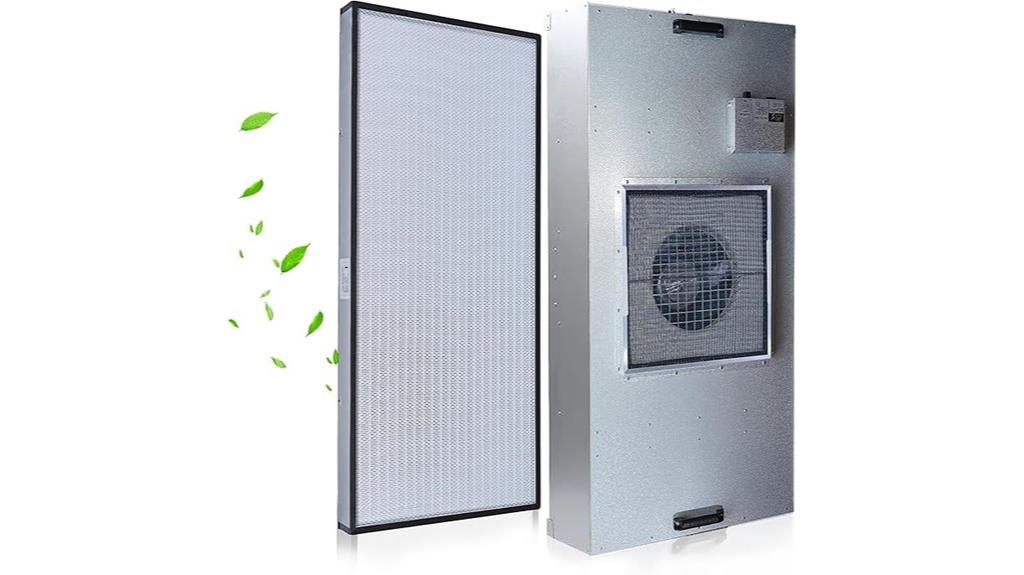
If you need reliable contamination control for sensitive tasks, the HEPA H14 Filter Laminar Flow Hood with Fan Filter Unit is an excellent choice. It’s CE and ISO certified, designed for cleanrooms, labs, and delicate environments like tissue culture and electronics repair. The FFU HEPA H14 filter removes 99.995% of particles ≥0.3 microns, exceeding ISO Level 5 standards. Built with durable materials such as galvanized steel, aluminum, and copper, it offers adjustable airflow and quiet operation. Its compact design supports wall mounting, making it versatile and effective for maintaining a sterile workspace with minimal contamination.
Best For: professionals and laboratories requiring reliable contamination control in sensitive environments like cleanrooms, tissue culture labs, and electronics repair workshops.
Pros:
- Supports ISO Level 5 cleanliness with 99.995% particle removal efficiency for particles ≥0.3 microns.
- Constructed with durable, high-quality materials such as galvanized steel, aluminum, and copper for longevity and safety.
- Compact design with adjustable airflow and wall-mount capability, suitable for various workspace sizes.
Cons:
- Weighs only 1 pound, which may require secure mounting to prevent movement.
- Noise level ranges from 41 to 65 dB, potentially noticeable in quiet environments.
- Limited information on additional features such as filtration lifespan or maintenance requirements.
JJFFTAO HEPA H14-Filter Laminar Flow Hood with Fan and Filter (Includes HEPA Filter) for Cleanroom and Laboratory
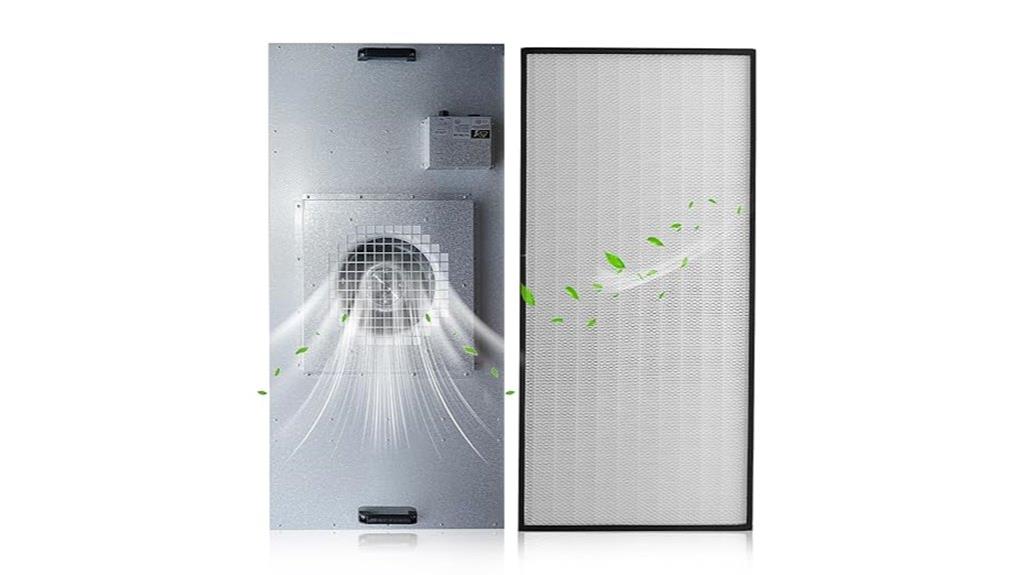
For those seeking reliable contamination control in cleanrooms and laboratories, the JJFFTAO HEPA H14-Filter Laminar Flow Hood stands out with its high-efficiency filtration and adjustable airflow. It features CE and ISO certifications, removing 99.995% of particles ≥0.3 microns and maintaining ISO Level 5 cleanliness. Built with durable galvanized metal, aluminum fan blades, and a copper motor, it ensures safety and longevity. Its dimensions are 46.2” x 22.6” x 11.37”, with airflow adjustable across three levels from 0.45 to 0.6 m/s. Perfect for sterile environments, it offers flexible application options for labs, cleanrooms, and more.
Best For: researchers, lab technicians, and cleanroom operators needing reliable, high-efficiency contamination control in sterile environments.
Pros:
- High-efficiency HEPA H14 filtration removes 99.995% of particles ≥0.3 microns, ensuring a contaminant-free workspace
- Adjustable airflow speeds allow customization for various applications and environments
- Durable construction with galvanized metal, aluminum fan blades, and copper motor ensures long-term safety and reliability
Cons:
- Dimensions may require significant space; not suitable for very tight or compact areas
- Requires a standard 110V power supply, limiting use in areas with different voltage standards
- The unit may need periodic filter replacements and maintenance to maintain optimal performance
Fan Filter Unit Laminar-Flow-Hood Yzzwer – FFU HEPA Filters for Clean Room
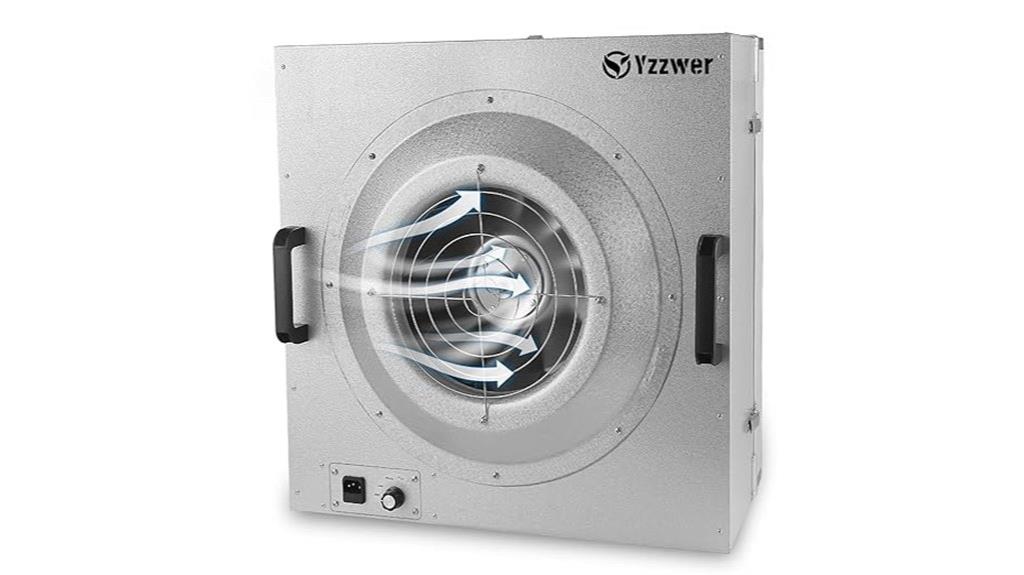
The Fan Filter Unit Laminar-Flow-Hood Yzzwer stands out as an ideal choice for cleanroom environments that demand reliable, high-efficiency airflow. Developed in 2023, it features an H13 HEPA filter that captures 99.99% of airborne particles ≥0.3 microns, ensuring ISO 5 cleanliness. Its continuous laminar flow maintains a dust-free environment perfect for mycology, laboratories, and clean rooms. With adjustable airflow speeds up to 0.60 m/s and 800 m³/h, it effectively removes contaminants. Easy to operate via push-button, users often add pre-filters for enhanced performance. Its solid build, responsive support, and value make it a top option today.
Best For: individuals and facilities requiring reliable, high-efficiency air filtration in cleanrooms, laboratories, or mushroom cultivation environments.
Pros:
- Provides ISO 5 (Cleanliness class 100) air quality with 99.99% HEPA filtration efficiency.
- Easy to operate with adjustable airflow speeds up to 0.60 m/s and 800 m³/h.
- Solid build quality and responsive customer support enhance user experience.
Cons:
- Assembly can be challenging due to unclear instructions, requiring minor wiring adjustments.
- Clips designed to secure the unit may hinder it from sitting flat on surfaces, necessitating modifications.
- No pre-filter included, so users often need to add their own for enhanced filtration.
12” Mini Portable Clean Room with Laminar Flow Hood
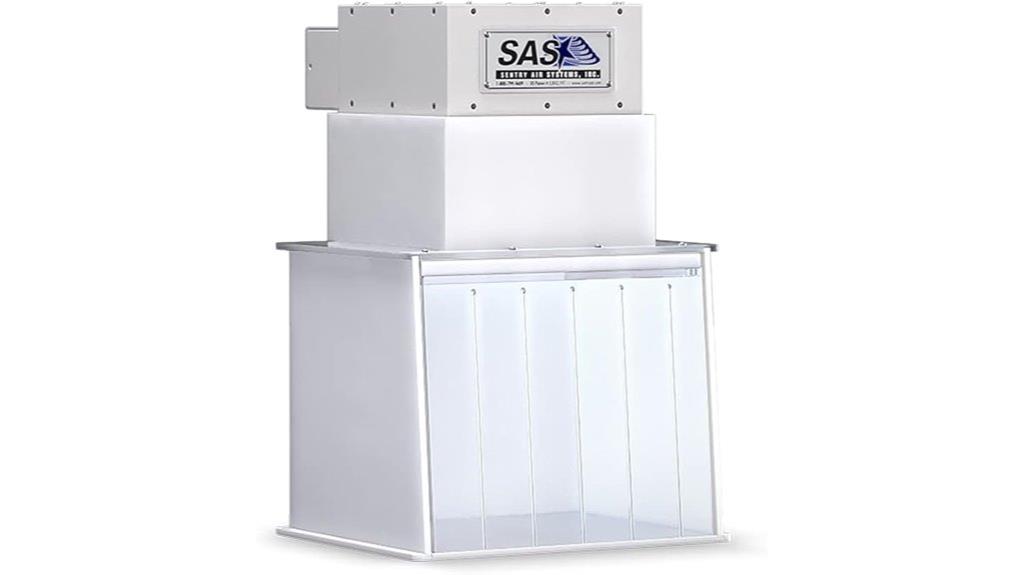
A 12-inch mini portable clean room with a laminar flow hood offers an ideal solution for professionals who need a compact, mobile workspace that meets strict ISO Class 5 standards. Its vertical laminar flow provides a positive-pressure environment with filtered, particle-free air, perfect for sensitive tasks like tissue culture or stem cell therapy. Designed to be lightweight and easy to move, it includes features like LED lighting, anti-static curtains, and a variable speed controller for airflow adjustment. With dual-stage filtration—pre-filter and high-efficiency HEPA or ULPA filters—it guarantees reliable, consistent cleanliness. Some setup is required, but its portability makes it an excellent choice for diverse medical and lab applications.
Best For: professionals in medical, laboratory, or field settings who require a portable, ISO Class 5 clean environment for sensitive tasks like tissue culture, stem cell therapy, or sterile sample preparation.
Pros:
- Compact and lightweight design for easy portability and integration into various workspaces
- Reliable dual-stage filtration with interchangeable HEPA/ULPA filters for high particle removal efficiency
- Features like LED lighting, anti-static curtains, and adjustable airflow enhance usability and static control
Cons:
- Some assembly required upon delivery, which may take additional time and effort
- Limited workspace size may not accommodate larger equipment or multiple operators simultaneously
- Noise levels from the fan may vary depending on airflow settings and could be disruptive in quiet environments
IV Hood for IV Bag Preparation, Portable Cleanroom, ISO Class 5
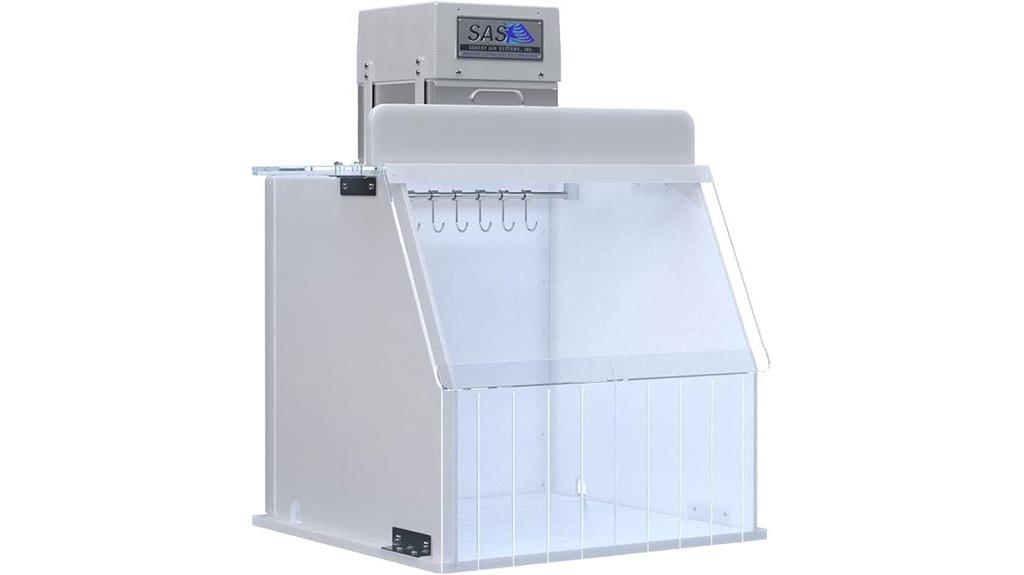
When preparing IV bags in demanding medical environments, the portable 18” wide IV Hood stands out as an essential tool, especially for facilities that need quick, reliable sterile conditions on the go. Its compact design and lightweight build make it easy to set up anywhere, from hospitals to mobile units. The hood ensures an ISO Class 5 environment with dual-stage filtration—HEPA or ULPA—reducing particles to maintain sterility. Features like LED lighting, anti-static curtains, and user-friendly controls enhance performance and ease of use. Weighing about 35 pounds, it’s built for durability and portability, making IV bag preparation safer and more efficient everywhere.
Best For: medical facilities, mobile clinics, and infusion centers seeking portable, reliable sterile environments for IV bag preparation.
Pros:
- Compact and lightweight design for easy portability and quick setup
- High-efficiency dual-stage filtration (HEPA/ULPA) ensures ISO Class 5 sterile environment
- User-friendly features such as LED lighting, anti-static curtains, and simple controls
Cons:
- Requires partial assembly upon delivery, which may require some time and effort
- Limited size may not accommodate larger or multiple simultaneous IV preparations
- Slightly higher initial investment compared to standard workstations
HEPA H14-Filter Laminar Flow Hood with Fan and Filter (Includes HEPA Filter)

Designed for high standards of cleanliness, the HEPA H14-Filter Laminar Flow Hood with Fan and Filter is ideal for laboratories, cleanrooms, and environments requiring ultra-pure air. It features CE and ISO certification and is crafted for ISO Class 5 cleanrooms. The hood guarantees consistent laminar airflow, capturing 99.995% of particles ≥0.3 microns. Its robust construction includes a galvanized frame, aluminum fans, and pure copper motors. With adjustable airflow speeds, ductless recirculating ventilation, and safety features like a lock, this hood provides reliable, efficient filtration. It’s perfect for sensitive applications such as tissue culture, electronics repair, and pharmaceutical work.
Best For: laboratories, cleanrooms, and sensitive environments requiring ultra-pure, particle-free airflow for tasks like tissue culture, electronics repair, and pharmaceutical work.
Pros:
- Certified CE and ISO standards ensure high-quality performance and safety
- Reliable HEPA H14 filtration captures 99.995% of particles ≥0.3 microns
- Adjustable airflow speeds and ductless recirculating ventilation offer flexible operation
Cons:
- First use may cause fuse blowing; requires replacing with a slow blow fuse
- Relatively heavy at 77.3 pounds, which may make installation less portable
- Limited customer reviews, with an average rating of 3.5/5, indicating mixed feedback
12×12 HEPA Horizontal Laminar Flow Hood

The x12 HEPA Horizontal Laminar Flow Hood offers a reliable solution for laboratories and clean rooms that demand contaminant-free workspaces. It features a high-efficiency filtration system, removing up to 99.995% of airborne particles, ensuring a pristine environment. With a steady airflow of 200 FPM, it provides consistent, reliable conditions for sensitive tasks. Its sturdy frame and clear acrylic shields offer durability and visibility, while its ergonomic design makes it easy to operate. Built for longevity, it requires minimal maintenance—just monthly cleaning with compressed air. Backed by a 12-month warranty and responsive support, it’s an excellent choice for precision work in 2025.
Best For: laboratories and clean rooms requiring a contaminant-free workspace for sensitive, high-precision tasks.
Pros:
- High filtration efficiency of up to 99.995% removes airborne particles effectively
- Steady airflow of 200 FPM ensures consistent, reliable conditions over extended use
- Durable construction with clear acrylic shields offers durability and excellent visibility
Cons:
- Limited dimensions (12 x 12 inches) may restrict workspace size for larger projects
- Requires monthly cleaning with compressed air, which may be inconvenient for some users
- No battery power, limiting portability and requiring an electrical outlet
Factors to Consider When Choosing Cleanroom Laminar Flow Hoods
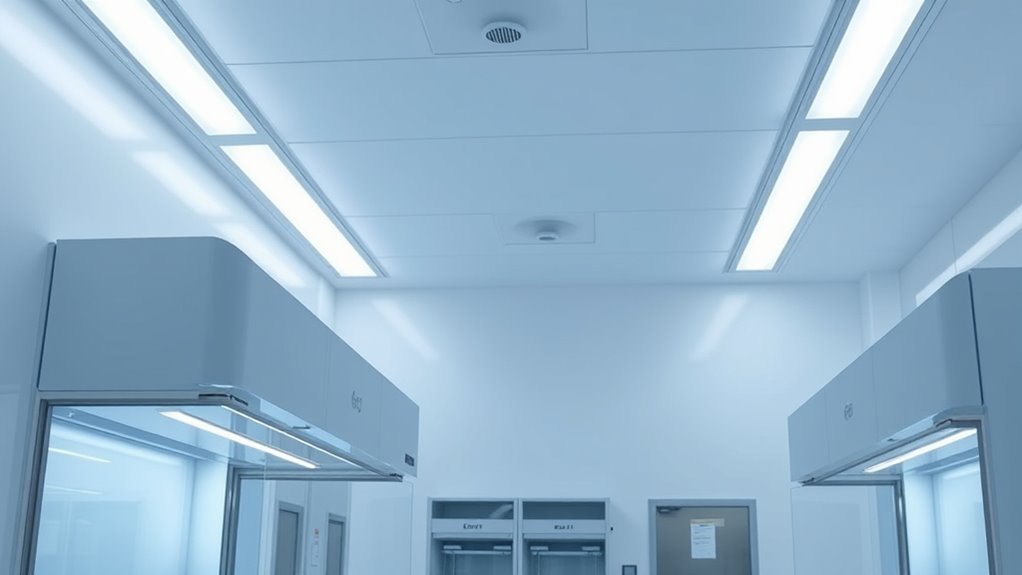
When selecting a cleanroom laminar flow hood, I consider several key factors to guarantee ideal performance. These include filtration efficiency standards, size and portability, airflow type, ease of maintenance, and operational noise and power consumption. Understanding these points helps me choose the right hood for my specific needs.
Filtration Efficiency Standards
How do you determine if a cleanroom laminar flow hood provides the right level of protection? The key is understanding filtration efficiency standards. For sensitive environments, filters must effectively remove airborne particles. HEPA filters, which meet ISO Class 5 standards, must achieve at least 99.97% efficiency for particles ≥0.3 microns. ULPA filters go even further, capturing up to 99.9995% of particles ≥0.12 microns, ideal for ultra-clean settings. These efficiency levels directly impact particulate reduction, essential for applications like pharmaceuticals, tissue culture, or semiconductor manufacturing. Certifications such as ISO 14644-1 and CE verify that a hood’s filtration system meets the required standards for its cleanroom classification. Ensuring compliance with these standards helps safeguard your work environment and product integrity.
Size and Portability
Choosing the right size and portability for your cleanroom laminar flow hood depends on your specific workspace needs and operational flexibility. I recommend selecting a size that matches your tasks—ranging from compact 12-inch units for small-scale work to over 30 inches for larger projects. Portable models are ideal if you need to move the hood frequently; they’re typically lightweight, under 50 pounds, with handles or casters for easy transport. Larger units offer more workspace but require dedicated space and sturdy support to remain stable. Consider how often you’ll relocate the hood or need it in different locations. Balancing size and portability guarantees your setup is both efficient and adaptable, fitting seamlessly into your lab or medical environment without sacrificing functionality.
Airflow Type and Quality
Selecting the right airflow type in your cleanroom laminar flow hood is vital for maintaining a contamination-free environment. Vertical airflow directs filtered air downward over the work surface, reducing turbulence and protecting sensitive procedures. Horizontal airflow moves filtered air from back to front, offering a clear view and minimizing disturbance of sterile conditions. The airflow quality depends on laminarity, which guarantees airflow remains uniform, with minimal turbulence or eddies. Maintaining high airflow quality is essential for meeting ISO Class 5 standards. Verification methods like flame tests help confirm steady, laminar airflow across the entire workspace. Choosing the appropriate airflow type and ensuring high airflow quality are key steps to optimize your cleanroom’s performance and safeguard your work environment.
Ease of Maintenance
When evaluating cleanroom laminar flow hoods, ease of maintenance is a crucial factor that can impact overall performance and operational costs. Regular filter replacement and surface cleaning are essential to maintain airflow and filtration efficiency. Look for units with accessible features like removable filters and simple panel designs, which make maintenance quicker and reduce downtime. Clear instructions and user-friendly controls help ensure proper cleaning procedures and prevent accidental damage. Choosing models with durable, easy-to-clean surfaces and low-maintenance components extends equipment lifespan and cuts ongoing costs. Additionally, routine performance testing, such as flame or lighter tests, helps verify airflow integrity and catch issues early, minimizing disruptions. Prioritizing ease of maintenance ensures your hood remains reliable, efficient, and cost-effective over its lifespan.
Noise and Power Usage
Noise levels and power consumption are critical factors that directly affect the usability and operational costs of cleanroom laminar flow hoods. Noise can range from 41 to 72 decibels, impacting user comfort and communication. For environments needing minimal distraction, lower noise levels (under 50 dB) are ideal, while higher levels might cause fatigue. Power consumption varies from 41 to 200 watts, influencing ongoing expenses. Energy-efficient models with variable speed controls let you adjust airflow based on task requirements, helping to guarantee a reduction in energy use and noise. Continuous operation at high speeds increases both noise and power consumption, so choosing a hood with adjustable settings is essential for balancing performance with efficiency. This ensures a quieter workspace and lower operational costs over time.
Application Compatibility
Selecting the appropriate cleanroom laminar flow hood requires careful consideration of its application compatibility to guarantee ideal performance and safety. I ascertain the filtration efficiency matches your particulate size needs—HEPA filters for 0.3 microns or ULPA for smaller particles. The airflow direction, whether vertical or horizontal, must suit your workspace to maintain contamination control and ergonomic comfort. It is crucial to verify that the hood’s size and workspace capacity accommodate your materials and equipment. Additionally, confirm compatibility with existing standards like ISO Class 5 to ensure compliance and contamination prevention. Finally, consider if you need extra features such as static control, adjustable airflow, or specialized filters, especially if your work involves sensitive or hazardous materials.
Frequently Asked Questions
What Are the Maintenance Requirements for Different Laminar Flow Hood Models?
Maintenance requirements vary by model, but I recommend regular filter checks and replacements to guarantee ideal airflow. I also clean the work surface and interior surfaces weekly to prevent contamination. For some models, I schedule periodic fan and motor inspections, and I always follow the manufacturer’s guidelines for calibration and part replacements. Staying consistent with these tasks keeps the laminar flow hood working safely and efficiently.
How Do Airflow Patterns Impact Contamination Control in Cleanrooms?
Airflow patterns are essential in contamination control because they direct particles away from critical areas. I guarantee that laminar flow hoods produce a consistent, unidirectional flow, which pushes contaminants out of the work zone. Proper airflow minimizes cross-contamination risks, maintains a sterile environment, and keeps the work area safe. When airflow is well-designed, I can trust that the cleanroom stays protected against potential airborne contaminants.
Are There Specific Certifications Needed for Laminar Flow Hoods Used in Medical Labs?
Think of certifications as the gold standard for safety and reliability. In medical labs, laminar flow hoods need to meet ISO 14644 standards and CDC guidelines, ensuring they control contamination effectively. I always recommend checking for UL or CE markings too, which indicate compliance with safety regulations. These certifications are like a shield, giving confidence that the equipment is up to par and safe for critical medical work.
How Do Noise Levels Vary Among Portable Laminar Flow Hood Options?
Noise levels in portable laminar flow hoods can vary quite a bit. Some models operate quietly at around 50-55 decibels, which is comparable to a normal conversation, making them suitable for noise-sensitive environments. Others might reach 60-65 decibels, producing a noticeable hum. When choosing, I recommend checking specific product specs, as quieter options often have advanced fan designs or soundproofing features that enhance working comfort.
What Energy Efficiencies Can Be Expected From High-Performance HEPA Filter Systems?
High-performance HEPA filter systems can markedly boost energy efficiency by reducing airflow resistance and optimizing filtration performance. I’ve noticed that advanced filters with better airflow design consume less power while maintaining cleanroom standards. Expect lower energy bills and improved sustainability. These systems often incorporate energy-saving features like variable speed fans and smart controls, which help balance performance with energy conservation, making your cleanroom operations more efficient overall.
Conclusion
Just like a lighthouse guides ships safely through dark waters, choosing the right laminar flow hood guarantees your work stays precise and secure. With the right equipment, you’ll navigate your lab tasks with confidence, avoiding hazards and maintaining a pristine environment. Remember, the right hood isn’t just a tool; it’s your beacon of safety and efficiency in the ever-changing landscape of cleanroom work. Let it light your path to success.
